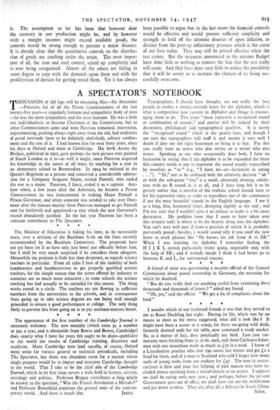Typographers, I should have thought, are not really the best
people to evolve a twenty-seventh letter for the alphabet, which is what a competition now current in Alphabet and Image is encour- aging them to do. This letter " must represent a recognised sound or combination of sounds," and entries will be judged by their decorative, philological and typographical qualities. It is surely the " recognised sound " which is the quarry here, and though I am sure the typographers will stuff it and mount it very well I doubt if they are the right huntsmen to bring it to bay. For this you really want an orator who also writes or a writer who also orates. Speaking as one who occasionally does both, I have no hesitation in saying that if the alphabet is to be expanded the letter this country needs is one to represent the sound usually transcribed by novelists as " er " (e.g., " I have no—er—hesitation in saying "). " Er," not to be confused with the relatively decisive " ah " or with the sub-grunt " hm," is a small, adenoidal, droning exhala- tion with no R sound in it at all, and I have long felt it to be grossly unfair that a novelist of the realistic school should have to hit his typewriter twice in order to reproduce one of the commonest if not the most beautiful sounds in the English language. I see it as a long, thin, horizontal letter, drooping slightly at the end ; and I'm not sure that I wouldn't give it an umlaut to make it a bit more decorative. My problem (now that I seem to have taken over this historic task) is where to fit the beastly thing into the alphabet. You can't very well oust Z from a position of which it is probably perversely proud ; besides, it would sound silly if you used the new letter in stock phrases like " He knows his job from A to ER." When I was learning the alphabet I remember finding the HI J K L stretch particularly tricky going, negotiable only with the help of ER ; and if nobody minds I think it had better go in between K and L, for sentimental reasons.






























 Previous page
Previous page